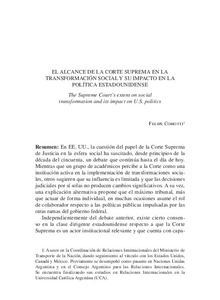Por favor, use este identificador para citar o enlazar este ítem:
https://repositorio.uca.edu.ar/handle/123456789/18532| Título: | El alcance de la Corte Suprema en la transformación social y su impacto en la política estadounidense The Supreme Court’s extent on social transformation and its impact on U.S. politics |
Autor: | Comotti, Felipe | Palabras clave: | Estados Unidos; CORTE SUPREMA; CIENCIA POLITICA; JUECES; TRANSFORMACION SOCIAL | Fecha de publicación: | 2022 | Editorial: | EDUCA | Resumen: | En EE. UU., la cuestión del papel de la Corte Suprema de Justicia en la esfera social ha suscitado, desde principios de la década del cincuenta, un debate que continúa hasta el día de hoy. Mientras que un grupo de académicos percibe a la Corte como una institución activa en la implementación de transformaciones sociales, otros sugieren que su influencia es limitada y que las decisiones judiciales por sí solas no producen cambios significativos. A su vez, una explicación alternativa propone que el máximo tribunal, más que actuar de forma individual, en muchas ocasiones asume el rol de colaborador respecto a las políticas públicas impulsadas por las otras ramas del gobierno federal. Independientemente del debate anterior, existe cierto consenso en la clase dirigente estadounidense respecto a que la Corte Suprema es un actor institucional relevante y que cuenta con capacidad para ejercer, a través de sus fallos, una influencia más allá del ámbito estrictamente judicial. Como consecuencia, la aprobación de jueces en el Senado se ha convertido, en los últimos veinte años, en un escenario de fuerte disputa entre Demócratas y Republicanos, lo que pudo observarse con claridad en 2020 durante el proceso de confirmación de la jueza Barret. In the United States, the question concerning the role of the Supreme Court in the social sphere has, since the early 1950s, prompted a debate that continues today. While one group of scholars perceives the Court as an active institution in the implementation of social transformations, others suggest that its influence is limited and that judicial decisions by themselves do not produce significant changes. Another alternative explanation proposes that the highest court, rather than acting individually, on many occasions operates as a collaborator with respect to public policies promoted by the other branches of the federal government. Regardless of the above debate, there is a certain consensus in the U.S. ruling class that the Supreme Court is a relevant institutional actor and that it has the capacity to wield, through its rulings, an influence beyond the strictly judicial arena. As a consequence, the approval of judges in the Senate has become, in the last twenty years, a scenario of strong dispute between Democrats and Republicans, which could be clearly observed in 2020 during the confirmation process of Judge Barrett. |
Cobertura Espacial: | Estados Unidos | Cobertura Temporal: | SIGLO XXI | URI: | https://repositorio.uca.edu.ar/handle/123456789/18532 | ISBN: | 987-978-620-552-8 | Disciplina: | CIENCIA POLITICA | Derechos: | Atribución-NoComercial-CompartirIgual 4.0 Internacional | Fuente: | González Levaggi, A., Robelo, C., Lazzaroni, C. (comps). La ciudad sobre la colina, Estados Unidos en el siglo XXI. Ciudad de Buenos Aires : Educa, 2022 |
| Aparece en las colecciones: | Libros/partes de libro |
Ficheros en este ítem:
| Fichero | Descripción | Tamaño | Formato | |
|---|---|---|---|---|
| CORTE-SUPREMA-TRANSFORMACION.pdf | 144,29 kB | Adobe PDF |  Visualizar/Abrir |
Este ítem está sujeto a una Licencia Creative Commons

